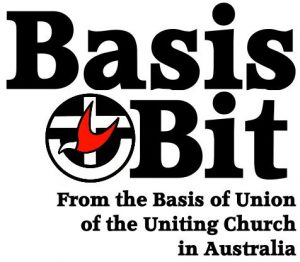23 June – Eavesdropping
Pentecost 2
23/6/2019
Hosea 1:1-10
Psalm 85
John 16:12-15
In a sentence:
God speaks to us by speaking to others
‘The Daily Prophet’ is the news rag in the extraordinary world of wizards and witches conjured up by JK Rowling in her Harry Potter series. There it serves in the way our own newspapers do, both advancing the common good and keeping it down, subject to the politics of its editors and the fears of the people. For better or for worse, Harry Potter and his exploits are often front page headline news in ‘The Prophet’.
If we were to imagine a different ‘Daily Prophet’ in eighth century Israel which gave account not now of wizarding news but of the oracles of purported prophets of God of the day, on which page would you imagine that Hosea’s preaching might feature? For then, as now, projections from the signs of the times would have been across a very broad spectrum, each voice refracting what seemed to be happening through a theological and political lens different from the others, each coming to a different conclusion. Would Hosea have been a page one or a page five prophet?
‘The word of the Lord that came to Hosea son of Beeri, in the days of…’
As we will see over the next few months, this was a concrete and specific word in a context very different from ours. Hosea makes a lively and vital address to his people in a time swirling with prosperity, religious and moral aberration, and looming geopolitical threats. Yet part of the liveliness of his preaching is that no one knows that God speaks through him. Is his word truly headline news, or just the odd-spot? No one knows at the time, and we can’t even speak here of the need to have ‘faith’ that Hosea speaks as God’s voice, for that speech was being heard for the first time in a context of plausible contradiction.
As it happened, the events unfolded in the way Hosea said they would and so Hosea’s interpretation of those events became an authoritative reading of the history, in retrospect. More important than this, however, is that Hosea’s interpretation became an authoritative interpretation of the character of God and of the relationship between God and Israel.
And so Hosea’s voice did not fall silent with the collapse of the northern kingdom. His oracles were preserved and became a tool for interpreting the prospects and then the fate of the southern kingdom, Judah, 140 years or so later. Now Hosea’s voice is heard differently. It has the authority of the events of 722 behind it. Back then a great divorce was said to be coming, and Assyria executed the judgement. But now there is a different dynamic in reading Hosea. The question is no longer, Is Hosea correct? This is already held to be the case, given what had happened in the north. The question is now, Do Hosea’s oracles apply here and now, in Judah, in relation to the threats and opportunities of the new situation? And in what way do they apply?
Again, events affirmed that they did apply, and this is reinforced by Jeremiah, Ezekiel and others who expanded upon the work of Hosea, Amos and Isaiah a century before. We hear Hosea and the other prophetic writings today on account of this ancient Jewish affirmation, taken up without question by the early church and retained by the church ever since as ‘witness’ to God’s work in and for the world.
All of this is to say that Hosea does not now address us directly, particularly if we simply decide that, for a while, we’ll sit with him and hear what he said. Our hearing of God’s word to Israel through Hosea is more like an eavesdropping on a conversation. If what Hosea said to Israel all those years ago is a word to us today, it is indirectly so.
Yet this indirect ‘overhearing’ of what passes between God and Israel is not just a matter of our being at a bit of a distance from the action and having to do deep interpretative work to get to the heart of the matter. There is certainly going to be plenty of that but, more importantly – and to exaggerate only slightly – our overhearing another God-conversation is the only way in which God communicates with us. Our relationship with God is always a matter of being ‘caught up’ in a communication which is not, at first, one which involves us. To be ‘saved’ is to overhear something someone did not first say to us.
We touched upon this last week, although it was hardly clear at the time. There we heard – as again this morning (John 16.12-15) – that the Spirit realises for us all that is of Jesus and – in Jesus – all that is of the Father. But prior to our receiving this communication of God to us through the Spirit, another communication has already taken place between the Father and the Son: ‘All that the Father has is given to me,’ Jesus says. This exchange between the Father and the Son does not, in the first instance, involve us. The Father and the Son are ‘in communication’ whether we are in the picture or not. That is all the names Father and Son denote: that these two, in the Spirit, are oriented toward each other in giving and receiving. The gospel is that the same Spirit is given to us to make ours what was not in the first instance about us.
Though Hosea would have little notion of what we call the Trinity, when we confess in the Creed that the Holy Spirit has ‘spoken through the prophets,’ this speaking does not in any way precede or go around the cross and all that Jesus’ ministry brings, even though Jesus comes after the prophets. The tension in Hosea between Israel being now ‘my people’, now ‘not my people’ (Hosea 1) and promised again to become ‘my people’ is the same tension in the incarnation, death and resurrection of Jesus. The old prophets do not only suffer – in some cases, at least – as Jesus later did, they proclaim him and his suffering.
To listen to the prophets, then, is to listen to what is happening in the very heart of God. What is happening in God preceded us and so is something which doesn’t need us. Yet, because of what love is, that divine discourse of love creates and embraces in a single motion – creates and embraces even us.
It will take us some time to come to a fuller account of what this means, and this is one of the strengths of working in detail through a text as we will do over the next couple of months.
But for today it is enough to understand that we are here – that we are created – because there is already a conversation going on which is worth hearing. Our lives are a matter of tuning into that exchange – connecting into God by connecting into God’s conversation with those who went before us – and becoming ourselves a conversation which others will need to overhear.
Let us, then, in the weeks to come with Hosea, open ourselves to the word of the Lord which came to him, that we might learn the word which will come to us today, and the word which God will make of us. Amen.



